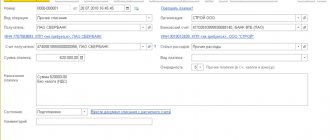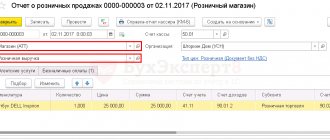How to convert currency in 1C?
When an organization works with foreign counterparties, it has to keep records of currency transactions and purchase (sell) currency. Currency conversion is one of the most popular topics among accountants who work with several currencies at once.
Let's look at a practical example of what steps need to be performed in 1C: Accounting 8 for Kazakhstan in order to automate and correctly process currency conversion in 1C.
Currency conversion in 1C
On October 22, 2020, foreign currency in the amount of $5,000 was purchased from AllianceBank under agreement No. 45. To reflect this operation, you need to do the following:
1.
Fill in the “Currency” directory with the exchange rate of the currency being converted on the date of the conversion operation.
2.
Write off funds from the tenge account in Alliance Bank in the amount of 746,700 tenge, using the
Payment Order document write-off
using the
“Other write-off of funds” operation.
Document date: 10/22/2020
Recipient
– JSC "Alliance Bank"
Sum
– 2 140 500
Cash flow item
– Other payments for operating activities
Account
– 1022
Counterparties
-
Alliance Bank JSC
DDS
article - do not fill out
When posting the document, the following transactions will be generated:
| Account Dt | Subconto Dt | Kt account | Subconto Kt |
| 1022 | JSC "Alliance Bank" | 1030 | Main account in AllianceBank |
| Other payments for operating activities |
3.
Generate a new document
Payment order receipt
by performing the operation
“Purchase of foreign currency”
Document date –
October 22, 2020
Account
– 1030
Incoming number
– 56 from 10/22/2020
Organization
– Biser LLP
Organization bank account
– Foreign exchange in AllianceBank in USD
Payer
– JSC "Alliance Bank"
Payer's bank account
– may not be specified
Bank account currency
– USD
Sum
-5000
Payer agreement
– Agreement No. 45
Type of agreement
– Other
Contract currency
– KZT
Amount in tenge at the acquisition rate
is filled in automatically and must match the amount that was written off using the
Payment order document written off
in the
“Other cash write-off” operation.
Currency acquisition rate
– 428.1
Market rate
(national bank rate) – 427.93
DDS article (receipt)
– Other income from operating activities
Settlement account
– 1022
DDS item (disposal)
- do not fill in
| Account Dt | Subconto Dt | Kt account | Subconto Kt |
| 1030 | Foreign exchange in AllianceBank in USD | 1022 | JSC "Alliance Bank" |
| Other income from operating activities |
If you have any questions, please contact our 1C Consultation Line, where you can receive qualified support from specialists
GLAVBUKH-INFO
The movement of funds in an organization’s foreign currency account consists of two main stages:- the stage of receipt (crediting) of funds to a foreign currency account, resulting in an increase in the amount of funds in the organization’s foreign currency account;
- the stage of writing off (transferring) funds from a foreign currency account, resulting in a decrease in the amount of funds in the organization’s foreign currency account.
Synthetic accounting of the availability and movement of funds in foreign currency on the organization’s foreign currency account is maintained on active account 52 “Currency accounts”.
The debit of account 52 “Currency accounts” reflects the receipt (credit) of funds to the organization’s foreign currency account.
The credit of account 52 “Currency accounts” reflects the write-off (transfer) of funds from the organization’s foreign currency account.
If an organization uses several currency accounts, then analytical accounting for account 52 “Currency accounts” is maintained for each currency account.
In accounting, business transactions for the receipt or debit of funds in foreign currency are reflected similarly to transactions on a current account with one difference - instead of account 51 “Currency accounts,” account 52 “Currency accounts” is used.
Transactions on foreign currency accounts are reflected in accounting on the basis of bank statements on the foreign currency account and the monetary settlement documents attached to them.
A bank statement on a foreign currency account is a register of analytical accounting and serves as the basis for entries in accounting accounts.
When a bank statement is received, the chief accountant (accountant) checks the accuracy of the entries in the foreign currency account based on the documents attached to it and enters the corresponding account code 154 against each entry.
After processing bank statements, completed business transactions are reflected in the book of business transactions. If supporting documents are not attached to the bank statement, then the amounts indicated in it are prohibited from being taken into account.
Amounts erroneously credited or debited to the organization's foreign currency accounts and discovered when checking bank statements are reflected in account 76 “Settlements with various debtors and creditors” (subaccount 76–2 “Settlements on claims”).
To record transactions on foreign currency accounts, an organization can open account 52 “Currency accounts”, in particular, the following sub-accounts:
- 52–1 “Transit currency accounts”;
- 52–2 “Current foreign currency accounts”, etc.
In accordance with the Chart of Accounts, other income and expenses are recorded in account 91 “Other income and expenses”.
Positive exchange rate differences are reflected in the credit of account 91 “Other income and expenses” (subaccount 91–1 “Other income”) in correspondence with the debit of accounts for cash, financial investments, settlements with suppliers and contractors, settlements for advances issued, settlements with buyers and customers, settlements on advances received, settlements with various debtors and creditors, etc.
Negative exchange rate differences are reflected in the debit of account 91 “Other income and expenses” (subaccount 91–2 “Other expenses”) in correspondence with the credit of accounts for cash, financial investments, settlements with suppliers and contractors, settlements on advances issued, settlements with customers and customers, settlements on advances received, settlements with various debtors and creditors, etc.
Exchange rate differences on balances in foreign currency at the organization's cash desk and in foreign currency accounts can be reflected in accounting by the following entries:
| Debit | Credit | ||
| 1. | A positive exchange rate difference is reflected in cash balances in foreign currency at the cash desk | 50 | 91-1 |
| 2. | A positive exchange rate difference is reflected in the balances on the current foreign exchange account | 52-2 | 91-1 |
| 3. | A negative exchange rate difference is reflected on cash balances in foreign currency at the cash desk | 91-2 | 50 |
| 4. | A negative exchange rate difference is reflected in the balances on the current foreign exchange account | 91-2 | 52-2 |
Documents confirming income or expenses in the form of exchange rate differences on balances in foreign currency at the cash desk and in foreign currency accounts of the organization are statements of foreign currency accounts and accounting certificates and calculations.
When buying and selling foreign currency through an authorized bank at the agreed actual rate, a negative or positive difference may arise due to a deviation of the actual sale (purchase) rate of foreign currency from the official rate of the Central Bank of the Russian Federation.
The difference that arises cannot be qualified as an exchange rate difference, since it is formed in connection with the use of two types of exchange rates: the official exchange rate of the Central Bank of the Russian Federation and the actual purchase (sale) rate of foreign currency.
The actual transaction of buying or selling currency is carried out at the actual sale (purchase) rate, and in accounting it is reflected at the official rate of the Central Bank of the Russian Federation.
If the agreed rate at which the bank purchased foreign currency for the organization is higher than the official rate of this currency established by the Central Bank of the Russian Federation on the date of acquisition of the currency, then a positive difference arises between the foreign currency purchase rate and the official rate of the Central Bank of the Russian Federation.
If the agreed rate at which the bank sells foreign currency to the organization is less than the official rate of this currency established by the Central Bank of the Russian Federation on the date of sale of the currency, then a negative difference arises between the foreign currency sale rate and the official rate of the Central Bank of the Russian Federation.
Tax aspects. In accordance with the Tax Code of the Russian Federation, for tax accounting purposes, exchange rate differences relate to non-operating income or expenses taken into account for profit tax purposes.
In accordance with the Tax Code of the Russian Federation, for tax accounting purposes, differences arising as a result of deviation of the sale (purchase) rate of foreign currency from the official rate of the Central Bank of the Russian Federation. established on the date of transfer of ownership of foreign currency, relate to non-operating income or expenses taken into account for profit tax purposes.
In accordance with the Instructions for the application of the Chart of Accounts, the receipt of export foreign currency proceeds to the transit foreign currency account of the organization is reflected in the debit of account 52 “Currency accounts” (subaccount 52–1 “Transit foreign currency accounts”) in correspondence with the credit of account 62 “Settlements with buyers and customers” .
The transfer of foreign currency earnings from a transit foreign currency account to a current foreign currency account is reflected in account 52 “Currency accounts” (by the debit of subaccount 52–2 “Current foreign currency accounts” and the credit of subaccount 52–1 “Transit foreign currency accounts”).
Foreign currency written off by the bank by order of the organization from the current foreign currency account for sale is reflected in the debit of account 57 “Transfers in transit” in correspondence with the credit of account 52 “Currency accounts” (subaccount 52–2 “Current foreign currency accounts”).
Income and expenses from the sale of foreign currency, as well as the resulting exchange rate differences, are reflected in account 91 “Other income and expenses.”
Income and positive exchange rate differences are reflected in the credit of account 91 (subaccount 91–1 “Other income”). Expenses and negative exchange rate differences are reflected in the debit of account 91 (subaccount 91–2 “Other expenses”).
Entries in subaccounts 91–1 “Other income” and 91–2 “Other expenses” are made cumulatively during the reporting year.
Expenses associated with payment for services and bank commissions are reflected in the debit of account 91 “Other income and expenses” (subaccount 91–2 “Other expenses”) in correspondence with settlement accounts, for example in correspondence with the credit of account 76 “Settlements with various debtors and creditors."
When selling foreign currency, such expenses of the organization include a commission to the bank for services provided for the sale of foreign currency.
By monthly comparison of debit turnover in subaccount 91–2 “Other expenses” and credit turnover in subaccount 91–1 “Other income,” the balance of other income and expenses for the reporting month is determined. This balance is written off monthly (with final turnover on the last day of the reporting month) from subaccount 91–9 “Balance of other income and expenses” to account 99 “Profits and losses”, which forms the final financial result as a whole for all types of activities of the organization.
In accounting, transactions related to the receipt of foreign currency earnings and the sale of foreign currency on the domestic foreign exchange market of the Russian Federation can be reflected by the following entries:
| No. | Contents of business transactions | Debit | Credit |
| Receipt of export foreign exchange earnings | |||
| 1. | of export proceeds for products shipped under the contract into the transit currency account of the organization is reflected | 52-1 | 62 |
| 2. | The transfer of incoming foreign currency earnings from 1 transit foreign currency account to the current foreign currency account | 52-2 | 52-1 |
| Selling foreign currency | |||
| 1. | Foreign currency to be sold is debited | 57 | 52-2 |
| 2. | The positive exchange rate difference that arose due to changes in the exchange rate of foreign currency on the date of its debit from the current foreign exchange account and on the date of its sale is | 57 | 91-1 |
| 3. | Ruble funds from the sale of foreign currency were credited | 51 | 91-1 |
| 4. | A commission was accrued to the bank for services provided in the sale of foreign currency | 91-2 | 76 |
| 5. | Commission paid to the bank for services in the sale of foreign currency | 76 | 51 |
| 6. | The cost of sold foreign currency has been written off | 91-2 | 57 |
| 7. | Profit (loss) from the sale of currency is reflected (as part of the final financial result) | 91–9 (99) | 99 (91-9) |
In accounting transactions for the purchase of foreign currency
on the domestic foreign exchange market of the Russian Federation can be reflected by the following entries:
| No. | Contents of business transactions | Debit | Credit |
| 1. | Funds were transferred | 76 | 51 |
| 2. | A commission was accrued to the bank for services provided for the purchase of foreign currency | 91-2 | 76 |
| 3. | paid to the bank from the current account for services for the purchase of foreign currency | 76 | 51 |
| 4. | The receipt of purchased foreign currency into the transit currency account is reflected at the exchange rate of the Central Bank of the Russian Federation on the date of its receipt | 52-1 | 76 |
| 5. | The excess of the foreign currency purchase rate over the rate of the Central Bank of the Russian Federation was expensed | 91-2 | 76 |
| or | |||
| 6. | The excess of the Central Bank of the Russian Federation exchange rate over the foreign currency purchase rate is attributed | 76 | 91-1 |
In general, the process of accounting for settlement transactions in rubles or in foreign currency, as a rule, includes the following steps:
- preparation or receipt of settlement documents reflecting settlement transactions (income or expenditure of funds in current and foreign currency accounts);
- registration of settlement transactions in bank statements (carried out by the bank);
- checking the correctness of entries in bank statements for current accounts and foreign currency accounts based on the settlement and payment documents attached to them;
- entry in bank statements against each; operations of the corresponding account number for use in the next stages of accounting work;
- transfer of data from bank statements to systematic (synthetic) accounting registers, where they are posted to accounting accounts.
Finally, the accounting process involves conducting an inventory of funds in current and foreign currency accounts, by comparing accounting data with the actual balance of funds in current and foreign currency accounts.
| < Previous | Next > |
Foreign exchange transactions and exchange control
Currently, due to the obsolescence of the supported formats for exchanging currency control documents, there is no sending of currency control documents to the bank; currency payment orders and downloading of currency statements are implemented.The possibility of direct exchange (only in 1C:DirectBank mode) with the bank for currency transactions is supported, including uploading/downloading documents:
- currency conversion;
- receipts and write-offs of funds in foreign currency;
- currency control and supporting documents when performing currency transactions.
The methodology is based on the current legislation on currency regulation and currency control:
- Bank of Russia Instruction No. 181-I dated August 16, 2017 “On the procedure for residents and non-residents to submit supporting documents and information to authorized banks when carrying out currency transactions, on uniform forms of accounting and reporting on currency transactions, the procedure and timing for their submission,” which came into force on March 01, 2018;
- Federal Law of December 10, 2003 No. 173-FZ “On Currency Regulation and Currency Control” as amended and supplemented.
To get started, you need to enable the functional option Master data and administration – Treasury – Payments in currency and currency control .
the Currency Control Documents tab appears the Treasury – Bank – Non-cash payments workplace , the use of which will help you create Certificates of supporting documents both independently and using an assistant.
At the same time, in the directories Master Data and Administration - Organizations and Contractors, it becomes possible to enter registration information in English. To do this, the fields Name – International General information tab ) and International address for payments (English) , tab – Addresses, telephone numbers .
Depending on the type of payment: write-off or receipt of foreign currency, the organization is subject to different requirements regarding the deadline for submitting currency control documents to the authorized bank, namely, the certificate and supporting documents attached to it are sent to the bank when:
- receipt of funds - no later than 15 calendar days from the moment foreign currency is credited to the organization’s bank account.
- write-off of funds - simultaneously with administrative documents for the transfer of foreign currency;
To fill out the Certificate of Supporting Documents , you need to enter data on the Main and Supporting Documents tabs, and also use the Files for transfer to the bank link to attach electronic copies of supporting documents (invoices, acts, invoices, customs declaration, letters to the bank, etc.).
When filling out the help on the Main tab, indicate:
- Organization;
- Bank – an authorized bank performing the functions of a currency control agent;
- Agreement – an agreement with a foreign counterparty under which settlements are made;
- Certificate date;
- Files for transfer to the bank – hyperlink to go to the window for adding attached files.
On the Supporting Documents tab, indicate:
- Information about the supporting document – number, date, data type selected from the list;
- Document type code – selected from a predefined list;
- Amount and Currency of the document;
- Amount in the currency of the agreement;
- Delivery attribute - selected from a predefined list;
- Expected date in date format;
- Country of the consignee (shipper) – selected from the classifier of countries of the world;
- Sign of adjustment;
- Note.
After posting the document Certificate of Supporting Documents, its printed form is displayed. To simplify the procedure for filling out help fields, it is recommended to use the Assistant for creating certificates of supporting documents .
In a situation where an organization participating in settlements with a foreign partner acts as the recipient of a payment in foreign currency, the receipt of funds to the organization’s transit account, in addition to the transfer order from the partner, is confirmed by the document Notification of Currency Credit .
the Treasury - Bank - Non-cash payments workplace during a direct exchange session with the bank using the command 1C: DirectBank - Synchronize with bank .
When funds in foreign currency are received into the organization's account, the legislation establishes a period (15 calendar days from the date of crediting the funds to the transit currency account) for providing documents confirming payment to the bank.
Treasury subsystem has developed a mechanism for automatically creating the necessary job tasks in the Current Affairs on the Home screen . In this case, money transfers for which the deadline for sending documents to the bank was missed are displayed in a separate list, highlighted in red.
Initially, foreign currency received from a foreign counterparty is credited only to the organization’s transit currency account.
Adding information about an organization's transit account to the Master Data and Administration directory - Master Data - Bank Accounts is possible both directly from the directory itself using the Create , and from the settlement (current) account card in foreign currency using the Transit . To indicate bank details in English, you need to edit them in the Master Data and Administration classifier - See also - Banks .
Next, the procedure for the mandatory sale of currency is carried out, as a result of which funds are transferred from the transit account to the current one, and the basis for creating a Write-off of non-cash funds with the document type Mandatory Sale Order is the Notification of Currency Credit . Conversion of foreign currency, in this case, is reflected using a separate document with the same type of business transaction.
Since the execution by a bank of most foreign exchange transactions is associated with the receipt and verification of the basis for their implementation, the organization is required to provide the bank with primary documents confirming the legality of the transactions performed. For this purpose, when making payments in foreign currency, in the documents Write-off of non-cash funds, it is possible to fill in the following data about:
- the method of charging a bank commission and additional instructions to the bank regarding payment - the Main ;
- currency transaction code, with the ability to add attached files using the link Files for transfer to the bank - Currency control tab.
Similar to documents for writing off non-cash funds, the indication of data on the method of payment of the commission and instructions to the bank is carried out when preparing the document Application for spending funds .
In order to replenish the balance of a ruble current account, organizations often resort to operations of selling foreign currency for Russian rubles. To do this, use the document Write-off of non-cash funds - Currency conversion , when filling it out, you can select the conversion rate and the account for charging a commission for the foreign exchange transaction performed by the bank.
Accounting for foreign currency conversion transactions
To carry out business activities, the enterprise periodically carries out foreign currency conversion operations. Use a specific example to show the correct calculation and reflection in the accounting records of an enterprise of foreign currency conversion operations.Answer
Foreign currency conversion is the exchange by banks of one type of foreign currency of a subject of foreign exchange transactions, bank, non-resident bank for another type of foreign currency at established exchange rates (clause 3.4.3 of the Instructions on the procedure for carrying out foreign exchange transactions with the participation of legal entities and individual entrepreneurs , approved by Resolution of the Board of the National Bank of the Republic of Belarus dated July 28, 2005 No. 112 (hereinafter referred to as Instruction No. 112)).
Foreign currency conversion refers to foreign exchange transactions (Article 12 of the Law of the Republic of Belarus dated July 22, 2003 No. 226-Z “On Currency Regulation and Currency Control”).
Since June 1, 2015, the conversion of foreign currency is carried out on the over-the-counter market (letter of the National Bank of the Republic of Belarus dated May 15, 2015 No. 32-16/277 “On the peculiarities of the functioning of the domestic foreign exchange market during the transition to the continuous double auction regime at the auctions of OJSC Belarusian Currency Exchange stock Exchange").
The procedure for converting foreign currency is defined in Instruction No. 112.
According to the National Accounting and Reporting Standard “The Impact of Changes in Foreign Currency Exchange Rates”, approved by Resolution of the Ministry of Finance of the Republic of Belarus dated October 29, 2014 No. 69 (hereinafter referred to as the National Standard), exchange rate differences (including when converting foreign currency) are reflected in the credit (debit) ) account 91 “Other income and expenses”.
There are the following types of foreign currency conversion:
- foreign currency conversion upon receipt;
- currency conversion on the over-the-counter foreign exchange market with crediting to an account opened in another currency;
- currency conversion on the over-the-counter foreign exchange market when making a payment with conversion.
Accounting for foreign currency conversion transactions upon receipt:
No.
| date | Account debit | Account credit | Sum | Contents of the operation (calculation) | |
| 1 | 20.07.2015 | 57.3 | 62 | 16,528,000= 1000 euros | Receipt of revenue in foreign currency if there is an account in a currency other than the currency of receipt, National Bank rate 16,528 rubles/euro |
| 2 | 24.07.2015 | 52.1 | 90.7 | 16,316,640= $1080 | Crediting to the account of the currency received as a result of conversion conversion rate 1.08 NB rate 15,108 rubles/dollar income taken into account when taxing profits in accordance with clause 3.19(5) of article 128 of the Tax Code of the Republic of Belarus (clause 13 of Instruction No. 102) |
| 3 | 24.07.2015 | 90.10 | 57.3 | 16,615,000= 1000 euros | Write-off as expenses the cost of the currency used for conversion, as of the date of conversion, expenses taken into account when taxing profits in accordance with clause 3.26(3) of Article 129 of the Tax Code of the Republic of Belarus, NB rate 16,615 rubles/euro (clause 13 of Instruction No. 102) |
| 4 | 24.07.2015 | 57.3 | 91.1 | 87 000= | Revaluation of foreign currency funds in transit between rates for the period on the date of transfer of foreign currency for conversion and on the date of crediting foreign currency after conversion (16,615 - 16,528) * 1000 NB rate 16,615 rubles/euro (National Standard, clause. 15 Instructions No. 102) |
Accounting for foreign currency conversion transactions on the over-the-counter foreign exchange market with crediting to an account opened in another currency:
| No. | date | Account debit | Account credit | Sum | Contents of the operation (calculation) |
| 1 | 20.07.2015 | 57.3 | 52 | 16,528,000= 1000 euros | Transfer of foreign currency intended for conversion NB rate 16,528 rubles/euro |
| 2 | 24.07.2015 | 52 | 90.7 | 16,316,640= $1080 | Crediting to the account of the currency received as a result of conversion conversion rate 1.08 NB rate 15,108 rubles/dollar income taken into account when taxing profits in accordance with clause 3.19(5) of article 128 of the Tax Code of the Republic of Belarus (clause 13 of Instruction No. 102) |
| 3 | 24.07.2015 | 90.10 | 57.3 | 16,615,000= 1000 euros | Write-off as expenses the cost of the currency used for conversion, as of the date of conversion, expenses taken into account when taxing profits in accordance with clause 3.26(3) of Article 129 of the Tax Code of the Republic of Belarus, NB rate 16,615 rubles/euro (clause 13 of Instruction No. 102) |
| 4 | 24.07.2015 | 57.3 | 91.1 | 87 000= | Revaluation of foreign currency funds in transit between rates for the period on the date of transfer of foreign currency for conversion and on the date of crediting foreign currency after conversion (16,615 - 16,528) * 1000 NB rate 16,615 rubles/euro (National Standard, clause. 15 Instructions No. 102) |
Accounting for foreign currency conversion transactions on the over-the-counter foreign exchange market when paying with conversion:
| No. | date | Account debit | Account credit | Sum | Contents of the operation (calculation) |
| 1 | 20.07.2015 | 57.3 | 52 | 16,528,000= 1000 euros | Transfer of foreign currency intended for conversion NB rate 16,528 rubles/euro |
| 2 | 24.07.2015 | 60, 62, 76 | 57.3 | 16,316,640= $1080 | The cost of the currency transferred to the counterparty as a result of conversion conversion rate 1.08 NB rate 15,108 rubles/dollar (clause 13 of Instruction No. 102) |
| 3 | 24.07.2015 | 90.10 | 57.3 | 298 360= | Write-off of conversion costs expenses taken into account when taxing profits in accordance with clause 3.26(3) of Article 129 of the Tax Code of the Republic of Belarus (16,615 * 1000 – 15,108 * 1080) (clause 13 of Instruction No. 102) |
| 4 | 24.07.2015 | 57.3 | 91.1 | 87 000= | Revaluation of foreign currency funds in transit between rates for the period on the date of transfer of foreign currency for conversion and on the date of crediting foreign currency after conversion (16,615 - 16,528) * 1000 NB rate 16,615 rubles/euro (National Standard, clause. 15 Instructions No. 102) |
In the income tax return, income (losses) from foreign currency conversion are reflected in lines 4.1 and 4.2, respectively. That is, according to clause 3.19(5) of article 128 and clause 3.26(3) of article 129 of the Tax Code of the Republic of Belarus, if in general for the reporting quarter a loss was received from the conversion of foreign currency, then it is reflected in line 4.2, if received income - then it should be reflected on line 4.1.
(30 opinions)
Tags:
- foreign currency





